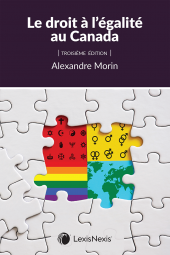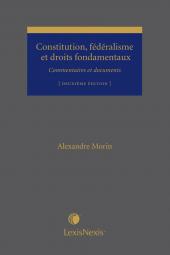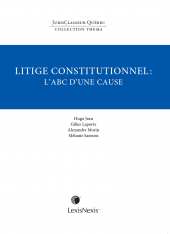Le droit à l'égalité au Canada, 3e édition
One Year Subscription Only Terms
Subscribers receive the product(s) listed on the Order Form and any Updates made available during the annual subscription period. Shipping and handling fees are not included in the annual price.
Subscribers are advised of the number of Updates that were made to the particular publication the prior year. The number of Updates may vary due to developments in the law and other publishing issues, but subscribers may use this as a rough estimate of future shipments. Subscribers may call Customer Support at 800-833-9844 for additional information.
Subscribers may cancel this subscription by: calling Customer Support at 800-833-9844; emailing customer.support@lexisnexis.com; or returning the invoice marked 'CANCEL'.
If subscribers cancel within 30 days after the product is ordered or received and return the product at their expense, then they will receive a full credit of the price for the annual subscription.
If subscribers cancel between 31 and 60 days after the invoice date and return the product at their expense, then they will receive a 5/6th credit of the price for the annual subscription. No credit will be given for cancellations more than 60 days after the invoice date. To receive any credit, subscriber must return all product(s) shipped during the year at their expense within the applicable cancellation period listed above.
Product description
L’égalité de droit entre les individus est sans doute l’un des piliers des systèmes de droit occidentaux et de l’organisation sociale qui en découle. Il suppose que l’on accorde juridiquement les mêmes possibilités à chaque individu : chacun peut voter, contracter, posséder des biens et avoir recours aux tribunaux pour défendre ses intérêts. À l’inverse, le droit à l’égalité suppose qu’il n’existe pas de citoyens de seconde zone, de personnes ayant, pour une raison ou une autre, moins de droits. Le droit à l’égalité est fondamental parce que sa violation entraîne les pires injustices. Sa violation à l’égard d’un groupe de personnes dans la société signifie qu’il existe une organisation sociale fondée non seulement sur des privilèges mais également sur la haine ou l’idée que certains êtres humains ne méritent pas, par leur nature, le même traitement que les autres.
L’ouvrage Le droit à l’égalité au Canada est le premier ouvrage uniquement consacré au droit à l’égalité, droit aussi fondamental que complexe. L’auteur s’est donné comme mission de couvrir ce thème en profondeur, d’en voir toutes les facettes, de critiquer en détail la jurisprudence et d’élaborer longuement sur chaque point, avec le souci, toujours présent, d’expliquer de manière simple, mais complète, les différents aspects et les précédents en matière de droit à l’égalité et de protection contre la discrimination au Canada.
Le but du présent ouvrage est donc de brosser un tableau complet de la protection du droit à l’égalité en droit canadien, à l’attention aussi bien des étudiants en droit que des avocats praticiens mais également des non-juristes. Tous pourront y trouver un outil de référence répondant aux questions qui découlent de la simple lecture de la loi ou d’un problème concret.
Table of contents
INTRODUCTION
CHAPITRE 1 : DÉVELOPPEMENT HISTORIQUE DU DROIT À L’ÉGALITÉ AU QUÉBEC ET AU CANADA
I. PÉRIODE PRÉCÉDANT LA SECONDE GUERRE MONDIALE
II. PÉRIODE D’APRÈS-GUERRE
III. ÉVOLUTION DU DROIT À L’ÉGALITÉ
CHAPITRE 2 : CHAMP D’APPLICATION DES NORMES ANTIDISCRIMINATOIRES
I. CHAMP D’APPLICATION DE L’ARTICLE 15 DE LA CHARTE
II. PORTÉE EXTRATERRITORIALE DE LA CHARTE QUÉBÉCOISE
III. CHAMP D’APPLICATION DE LA LOI CANADIENNE SUR LES DROITS DE LA PERSONNE
CHAPITRE 3 : ARTICLE 15 DE LA CHARTE CANADIENNE
I. ÉTENDUE DE LA PROTECTION : « LA LOI NE FAIT ACCEPTION DE PERSONNE. . . »
II. COEUR DE L’ARTICLE 15 :
« . . . INDÉPENDAMMENT DE TOUTE DISCRIMINATION. . . »
III. RAPPORTS ENTRE ARTICLE 15 ET ARTICLE PREMIER DE LA CHARTE
IV. CONSÉQUENCE D’UNE VIOLATION DE L’ARTICLE 15 DE LA CHARTE
CHAPITRE 4 : MOTIFS DE DISCRIMINATION
I. RACE, ORIGINE NATIONALE OU ETHNIQUE ET COULEUR
II. RELIGION
III. SEXE
IV. ÂGE
V. DÉFICIENCES MENTALES OU PHYSIQUES
VI. LIEU DE RÉSIDENCE
VII. CITOYENNETÉ
VIII. ÉTAT MATRIMONIAL ET ÉTAT CIVIL
IX. ORIENTATION SEXUELLE
X. LANGUE
XI. CONDITION SOCIALE
XII. CONVICTIONS POLITIQUES
XIII. ANTÉCÉDENTS JUDICIAIRES
XIV. GENRE
CHAPITRE 5 : DISCRIMINATION EN DROIT PRIVÉ
I. EN DROIT PRIVÉ QUÉBÉCOIS : ARTICLE 10 DE LA CHARTE QUÉBÉCOISE COMME NORME D’ÉGALITÉ GÉNÉRALE
II. PROTECTION CONTRE LE HARCÈLEMENT
III. INTERDICTIONS PARTICULIÈRES DE DISCRIMINATION
IV. EN DROIT FÉDÉRAL : LOI CANADIENNE SUR LES DROITS DE LA PERSONNE
CHAPITRE 6 : MESURES POSITIVES EN FAVEUR DE L’ÉGALITÉ
I. PARAGRAPHE 2 DE L’ARTICLE 15 : PROGRAMMES AMÉLIORATEURS
II. PROGRAMMES D’ACCÈS À L’ÉGALITÉ EN EMPLOI
III. PROGRAMMES DE PROMOTION SOCIALE
IV. ÉQUITÉ SALARIALE
V. AUTRES INITIATIVES QUÉBÉCOISES ET FÉDÉRALES
CHAPITRE 7 : RECOURS ADMINISTRATIFS EN MATIÈRE DE DROITS DE LA PERSONNE
I. AU QUÉBEC – EN VERTU DE LA CHARTE DES DROITS ET LIBERTÉS DE LA PERSONNE
II. AU CANADA – EN VERTU DE LA LOI CANADIENNE SUR LES DROITS DE LA PERSONNE
CONCLUSION
ANNEXES
CHARTE CANADIENNE DES DROITS ET LIBERTÉS, PARTIE I DE LA LOI CONSTITUTIONNELLE DE 1982, CONSTITUANT L’ANNEXE B DE LA LOI DE 1982 SUR LE CANADA, C. 11 (R.-U.) (EXTRAITS)
CHARTE DES DROITS ET LIBERTÉS DE LA PERSONNE, RLRQ, C. C-12
LOI CANADIENNE SUR LES DROITS DE LA PERSONNE, L.R.C. 1985, C. H-6
TABLE DE LA LÉGISLATION CITÉE
TABLE DE LA JURISPRUDENCE CITÉE
BIBLIOGRAPHIE
INDEX ANALYTIQUE
 Lexis Nexis
Lexis Nexis 


